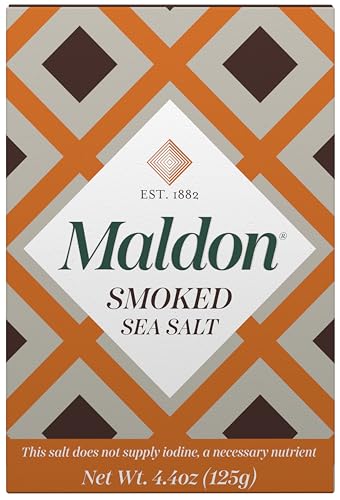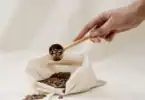Several years ago, I started to hear about Maldon Salt. Sometimes it would be called out in a recipe or on the menu in a high end restaurant. It was clear that I needed to seek out a source for this salt so that I could check it out for myself.
I couldn’t find any of my local grocery sources that seemed to carry it – and at that point I didn’t even know that I was looking for a green box. After doing some online research, I ordered a box – and also learned that this unique salt is usually considered to be a ‘finishing salt’, so I needed to understand what that meant to me in the kitchen.
It is rather exciting to share what I learned. This the clearly the best item I have added to my kitchen in a long time. It elevates the enjoyment that I get from my cooking immensely.
What is Maldon Salt?
Maldon Salt is a naturally occurring salt (primarily Sodium Chloride) that was discovered in the coastal town of Maldon in Essex, England. So it is an evaporated sea salt, characterized by very large, pyramid-shaped crystals. The crystal structure gives it a distinctive flaky texture. It is often used as a finishing salt, sprinkled on dishes just before serving to enhance the flavor rather than being cooked into the food during preparation.
Chefs and more and more home cooks are using Maldon salt because of it’s almost floral flavor, clean & bright taste and slightly crunchy texture. The large crystals can be pinched between your fingers to sprinkle onto your food and to break the bigger crystals into smaller pieces.

Find Maldon Salt by looking for this distinctive Green box. This 8.5 ounce (240 gram) box holds enough salt to last me for months.
Sprinkling by hand (or pinch) is definitely my preferred way of using this salt. It would be a shame to put it in a ceramic grinder and the crystals are too large to have it work in a salt shaker. Maldon salt is ideal for seasoning a variety of dishes like vegetables, potatoes, meats and even baked goods.
8.5 ounces of Maldon Sea Salt fills this glass container to the top. After several months of use, I have only used about half of it. Just a small sprinkle enhances food items from grilled salmon to sautéed veggies.

This is a 240 gram (about 8.5 ounce) package of Maldon salt. It comes in the traditional (and recyclable!) green box.
What is the Appeal of Maldon Salt?
Maldon salt is favored by chefs, home cooks and anyone with a discerning palette for food for many reasons:
Taste
It has a cleaner, milder and more floral taste when compared to common table salt, which can have a sharp, harsh or overly salty flavor. It brings out the natural flavors of food without overpowering them.
Flaky Texture
The large, flaky triangular crystals of Maldon salt give it a unique crunch and lightness that make it a perfect finishing salt. The texture alone makes this salt appealing on top of any savory dish.
Visual Pleasing
The pyramid-shaped flakes look lovely and may even sparkle when lightly sprinkled on dishes, adding elegance and visual appeal. It is particularly nice on homemade Pretzels or Caramels.
Minimally Processed
Maldon salt is produced by evaporating seawater from the Thames Estuary, a method which many consider more natural and pure than commercially processed salts. This salt has been produced in this natural way since 1882. If you’re interested in knowing about the history of this salt region and how the salt continues to be produced, see this Wikipedia Page about Maldon Salt.
Meltability
The flaky structure and non-compacted nature of Maldon salt allows it to dissolve quickly, making it perfect for adding salty seasoning that brings out the flavors in your food.
Using Finishing Salt
I just keep that cobalt colored jar on the dinner table. I just pinch out a bit from the jar and sprinkle on! It really takes only a little bit to ‘pop’ the flavor of foods.
I’ve seen a number of recipes that just call for Maldon salt in place of common salt, but this seems like a bit of a waste. Perhaps those folks have even more refined palettes than I do, but it seems like the salt would just get lost in the other flavors. This salt deserves to be on top. Drizzle it on top of homemade caramel or sprinkle a bit on shortbread cookies. It is terrific on top of homemade bread or pretzels.
Maldon salt can be placed in a salt grinder or mill, but it is so soft and easy to crush up that you don’t really need one. Don’t bother trying to put it in a salt shaker – most of the pieces will not fit through the holes.
How to Store Your Maldon Salt
Since salt is a natural desiccant, it wants to absorb moisture from the air. Even in Colorado, I store my Maldon Salt in a small glass jar with a cork lid.

If you find that your salt is clumping, try adding a packet of desiccant in the bottom of the jar to absorb any excess moisture. This packet has kept my salt in great shape for months.
Traditional salt shakers don’t dispense this type of salt well. If you don’t have a functional jar like mine, consider purchasing a salt cellar or a metal tin with a tightly fitting lid to store your salt.
Reducing My Sodium Intake
I fortunately do not have to watch my sodium intake closely, but I do try keep it in mind so that it doesn’t become a health issue. Since I’ve been using Maldon salt, I think I have actually reduced my intake. Since I am using this salt on top of my food, I am using a lot less salt when I am preparing the food. I also no longer have table salt on my table – I only use a variety of finishing salts. The original 8.5 ounce box of Maldon has been in use for months and I still have not used the entire amount.
Maldon Salt is not very dense since it has such a flaky structure. You get the satisfaction of the salty taste while consuming less sodium than you would from chunky Kosher salt or plain ol’ table salt.
Bonus Salt & Calorie Reduction Idea: You can use less cheese on top of foods such as pasta, salads or homemade pizza. Instead, sprinkle a bit of Maldon Salt just as the food is being served and you may find that you don’t miss the cheese at all.
Maldon Salt in Flavors!
In addition to the original, unflavored Maldon Salt in the green box, it is also offered in three flavors, Smoked, Garlic, and Chili (with Aleppo and Bird’s Eye chiles).
Maldon in the Smoked Sea Salt variety. For other articles on smoked salt, see From Sea To Smoker: Your Guide To Homemade Smoked Salt and The Economics Of Smoked Salt: Is It Worth The Price?

A small box of Smoked Maldon salt: 125 grams is about 4.4 ounces. A little pinch of this flavorful & smoky salt can go a long way in flavoring meats or sprinkling lightly over a salad.
Frequently Asked Questions
Can I cook with Maldon Salt?
You can cook with Maldon Salt, but it’s unique texture and flavor may get lost as it dissolves into the food. Maldon salt is quite a bit more expensive than other salts best used for cooking and baking, such as kosher salt or common table salt.
Is Maldon Salt the same as kosher salt?
No; while both salts are primarily sodium chloride, kosher salt is denser and coarser than Maldon salt. Usually (although this is dependent on the kosher salt you select) Maldon salt will have more trace minerals and may be more minimally processed. Maldon salt will be more flaky and will show a delicate pyramid structure and a light texture as compare to kosher salt.
Is Maldon Salt healthier than regular table salt?
Nutritionally, both salts are primarily sodium chloride, but Maldon salt may retain more trace minerals and be more minimally processed than most common table salt. Due to being less dense, Maldon salt has less sodium chloride by volume, which may assist users in consuming less sodium while still having the satisfaction of the salty taste.
Is Maldon Salt iodized?
No – like most sea salts and other artisanal culinary salt, Maldon is non-iodized.
Does Maldon Salt expire?
No – salt does not ‘go bad’. The date on your package is more of a ‘best by date’ which has more to do with the salt staying free of clumping, hardening, or absorbing odors from other nearby stuff in the cupboard. You can safely use salt well after any date on the package, but you may need to grind it up in a mortar & pestle to get it in a state to sprinkle or pinch it.
Is Maldon Salt sustainable?
Yes, the Maldon Crystal Salt company claims to use traditional, low-impact harvesting methods and sustainable practices.
Is Maldon salt vegan and gluten-free?
Yes – but also all minimally processed sea salt (and any salt without additives) is vegan (no animal products) and gluten-free (no wheat products).
Other Finishing Salts
I have two other finishing salts that I use, but neither get as much food time as the Maldon. I thought I would mention them though, because certain foods can benefit from certain salt flavor profiles.
Pink Himalayan Salt – You can sometimes find pink salt that has been processed into flakey crystals through an evaporative process, but that salt tends to be spendy and – as mentioned, hard to find. Instead, I put Pink Himalayan salt in a ceramic grinder and the process of crushing it makes a nice finishing salt sprinkle on my food. Try it on freshly cooked eggs! For more about this tasty salt, start with this article: Comparing The Taste of Pink Himalayan Salt to Regular Salt.
Maldon Salt Alternatives – I recently completed an article on the salts I know of that are as close to direct replacements for Maldon Salt as possible. Maldon Salt Alternatives explores substitutions that consider factors like price and location (salts produced in the U.S.) when selecting a finishing salt.
Celtic Sea Salt – I also like French grey ‘sel’ for finishing. This salt deserves it’s own article … but I haven’t gotten that one done yet. Coming soon!
Celebrity chef Samin Nosrat, author of “Salt, Fat, Acid, Heat: Mastering the Elements of Good Cooking” said in a recent interview that she uses lots of flaky salt, mentioning Jacobsen and Maldon as her salt pantry staples, and a Scottish salt called Blackthorn as her current favorite. If you haven’t read her book, or watched the accompanying 4-part Netflix series that was produced after the book was a best seller, you really should check it out. I’ve linked the book title to make it easy to find on Amazon.
Final Thoughts
Don’t just dump some table salt on food – live a little and make it something special with a finishing touch like Maldon Salt!
If you are looking for the perfect Salt Cellar to store your Maldon salt, be sure to see Salt Storage: Choosing a Salt Cellar, Salt Grinder, and More.









